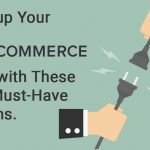As someone who lives and breathes e-commerce, I spend a ton of time in related Facebook groups, on Reddit, and Quora reading questions and answers regarding how to make money with an online store. There’s a lot of redundancy; people asking the same questions others have asked. It gets old, but it points out some really common problems for why online stores fail to get off the ground.
Among the primary reasons new stores fail is a misunderstanding of what is required to succeed with an online store. There’s massive confusion over Shopify, created in part by their own marketing, that the software can make you rich. I Googled “how to become a millionaire with Shopify?” There it is, a list of articles, the top ones all actually written by Shopify, making it sound easy. 2700 people a day become millionaires! That’s utter rubbish. While some people do find Shopify a tool that can help them reach business goals, if they are successful in business, it won’t be because Shopify made it happen.
Shopify isn’t going to make you rich. Not by a long shot!
Now I’m not saying there aren’t some nuggets of useful information within that list of articles. I am saying that Shopify is not going to make you rich. It can’t. Why not? Because it’s just software. A tool. Nothing more. Your shovel doesn’t make your garden grow. The gym doesn’t make you thin.
Yet there are scores of people out there telling you that Shopify will make you money, and this is a wholly deceptive suggestion. The fact that Shopify itself is making this claim is really sad, and misleading. It takes so much more than a single software program to build a business, especially a successful one.
The truth is that many people do build successful e-commerce businesses. More often than not, new stores fail. The funny thing is that when I tried to find actual success and failure statistics specifically for Shopify-based stores, I found pages of sources with headlines like “Why 95% of Shopify stores fail.” When I attempt to find actual numbers for Shopify specific businesses, I find several stock analysts that discuss the high churn rate (think of a revolving door) for new stores on the Shopify platform. Analyst, Jan Barta says, “77% of customers churn off before reaching their first anniversary.” Since Shopify is a publicly-traded company, these numbers can be extracted from their annual reports.
Misconception number one – equating a shopping cart with a marketplace
I was in a popular e-commerce Facebook group tonight where the question was “where should I start – eBay, Amazon, or Shopify?” That’s actually a great question, but the very first answer was “I do Amazon, eBay, and Storenvy for my channels. I added Shopify last month at 200/month and I didn’t get a single sale from Shopify so I shut it down after the first month.” Instantly I saw his problem, he thought they were all the same. After I responded that they were not the same, this gentleman responded with ” I didn’t understand the monthly fee was only to have the store running. There isn’t any marketplace or traffic driven with the monthly subscription. Once I realized that I bailed.”
A marketplace comes with an audience. Ebay, Amazon, and Etsy are just a few of many popular marketplaces. A marketplace has multiple sellers. You pay a fee to list and sell products on their website. They own the customer and there are generally very strict rules about how you engage with customers. Attempts to move the people who buy from you on the marketplace, off to your own site, is forbidden and can get you banned from the site. Because the marketplace is a trusted brand, and they almost always back up the customer, people will buy from you, the unknown seller, easier than they may if they found your website.
NEW for 2020 – Shopify does now have a marketplace known as Shop. It’s an app-only marketplace and it’s still in its infancy so the search on it is pretty terrible. They will improve it in due time. It does require that you use Shopify Payments in order to qualify, which rules out many stores. It’s too early to tell if this is going to help stores sell more. It may. The problem I see is that shoppers need to see value in downloading the app. Time will tell. The Shopify marketplace is only open to Shopify stores.
The downsides of a marketplace
You don’t own the customer or the relationship with the customer. You have to play by the marketplace’s rules. Typically if there’s a dispute they side with the customer. This can be frustrating. They control how visible your product listings are, and increasingly visibility is a “pay to play” game. They can terminate your relationship at any point. Amazon is famous for quick suspensions and ending seller relationships for what often seems like a minor infraction. Sometimes the customer is wrong. It doesn’t matter. You’re still toast. Still, it is possible to make excellent money selling on a marketplace or several.
Your own web store
You own the domain and choose your name. You’ll need shopping cart software to begin. You may need more than that, it depends on what you choose and what features and functions you need to operate your online store. Shopify is one of many brands of shopping carts. It’s well known and very popular with new and smaller stores. However, it isn’t superior by virtue of name recognition. While it is a solid choice, it may or may not be a good choice for your business. You shouldn’t be making your cart choice based on advertising. It’s really important to build a specification and choose a cart based on your business’ specific needs.
There are many factors that differentiate shopping carts and a number of other excellent choices. Among other top contenders BigCommerce, WooCommerce, Salesforce, and Magento are also well-known names. Each is different from the others and before you choose one, you should have a clear picture of the technology you need to do business. Otherwise, you’ll be replacing your cart software with another in short order. I’m not going to cover their differences in this article. If you’d like to know how to pick the best cart, please feel free to contact me.
What is the difference between a web store and a marketplace?
There are many differences, all very significant. It’s important to understand these differences so you can build your business plan accordingly. I also want to emphasis here, for many online businesses, it isn’t an either/or choice. Many, many companies operate more than one online sales channel. You may decide you want to sell on marketplaces and on your own website.
Difference #1 – you have to bring an audience
Marketplaces spend a lot of money driving traffic to their website. When you own the site, you have to drive the traffic. It gets harder than that. “Just traffic” isn’t enough. It has to be targeted traffic. This means that the people that come to your site are interested in what you sell, and are ready to buy. There are many ways to drive traffic but in the beginning, it almost always requires spending money.
Advertising is usually the fastest way to bring buyers. Other traffic drivers include social media, finding influencers to write about, or talk about, or post about, your products, and search engine optimization (SEO). SEO takes time before it will drive an audience and a lot of content, so that leaves largely paid options for brand new stores. Over time, you can add email marketing, referral marketing, and affiliate programs to drive sales but these are not powerful tools until you have actual sales volume rolling in.
Difference #2 – you have to earn their trust
The customer on the marketplace buys from you primarily because they trust the marketplace to have their backs. You are trading on their brand trust, not your own. Even with this level of support, sellers who don’t have a lot of positive customer feedback experience slower sales until they build up good reviews. When you have your own store you have to build trust and appear trustworthy from your very first day. This is a lot of work.
Your store must appear, and be, trustworthy. This means it operates well, looks great, is well organized, and has well-written policies regarding shipping, returns, and privacy. Customers must also be able to contact you. In most cases, stores that do not publish a local address and phone number will appear less trustworthy and not do well. Spelling and grammar must be impeccable. Product photos need to be clean and consistent. Product descriptions should be original and well written. Your site must be secure. This all marks just the beginning of building trust.
Building brand trust
In addition to all the physical requirements I just mentioned, you have to build a brand. Remember brand trust is what drives customers to buy on Amazon, Walmart, and eBay. They have it. Your brand new store does not. The discussion of how to build a trustworthy brand can be lengthy. In the name of brevity, I will narrow it down to three areas – brand visibility, social proof, and most importantly, a unique value proposition (UVP).
Brand visibility
This is all about being seen. Everywhere. On social media, on YouTube, across the Internet, and if you can afford it, on TV or radio. While it is possible to build a lot of visibility on social merely through your own effort, in most cases branding involves spending money. Branding efforts target the top of the marketing funnel (you should read up on the marketing funnel if you don’t know what it is). This means it doesn’t necessarily drive direct and immediate sales. Branding builds awareness of your existence and helps foster trust.
Social proof
Social proof is quite simply other people saying good things about your brand and your products. You’ll want to gather reviews for your products and reviews that talk about how great your service and store is. You want your customers to tell their friends. You want social media personalities with engaged audiences to talk about your brand and products.
Unique Value Proposition
You need to think through and create a UVP before you open your store. Your UVP answers the questions “why should I buy this product from this merchant?” If I ask you what the UVP is for Amazon what you would answer?
Amazon offers an amazing selection of products at competitive prices. What’s more, I can get my order, no matter how small, delivered to my house within 2 days for free. What’s more, I know that if I don’t like what I bought, I can send it back for $1 without any hassle.
That’s a very competitive UVP and I will add that you need to pay attention to it. While you do not necessarily need to match it, you will be competing against it. Consider Amazon as you design your own unique value proposition. Customers expect great service and products at competitive prices.
If owning your own store is more work, why bother?
Because it is yours. You control the UVP, the merchandise selection, your site’s visibility, and the terms under which you conduct business (like return policies). Site visitors are exposed to everything you offer, not one product at a time. You can re-market to people who come to your website or who have purchased from you before. You can offer up-sells and cross-sells. This increases the sales volume you get from each site visitor and customer. You can ask for referrals so your customers send new customers to your business (a referral program is one of your cheapest ways to acquire new customers).
When you conduct business on a marketplace, you are subject to their rules and the visibility they choose to give your products. Your products are always shown against the competition. So while costs can be higher, at least in the beginning, to build your own online store, in the end, the potential is much greater.
Before you start your online business
Do your homework. A lot of it. Understand where your products fit the market both in competitiveness and pricing. Understand your customer. What do they like, what are their pain points, how does your product solve their problems or create desire? Learn the marketing funnel so you can work customers at all stages of their buying journey. Learn about online marketing and plan a budget. Define what features you must have, would like to have, and don’t need before you choose your software. Will you drop ship or stock products? If you drop ship can you deliver within the short delivery times customers expect? Here is an article I wrote on the 4 Key Factors You Must Have to Build a Successful Ecommerce Website.
Build a business plan. Set goals and Key Performance Indicators (KPIs). You need a measuring stick to know where you’re making progress so you invest your time and money wisely. Be prepared to work a lot of hours in the beginning. Little effort rarely yields results. Eventually, you can hire help and relax more.
It is possible to make a lot of money with an online store
Now that you have a clearer picture of what is involved in setting up and running an online store, it’s pretty obvious that Shopify won’t make you rich. Shopify can’t make you rich. Can it be one of the many tools you’ll use to build a successful business? Yes, it can, but that doesn’t mean it’s your best choice, as it is one of many similar tools and “best” requires a solid fit for your needs. In order to build a successful e-commerce store, you need many things. The most important things you need to get going are a solid business plan and the willingness to put in a lot of effort, coupled with some cash to start your marketing.
Go forth and prosper!






